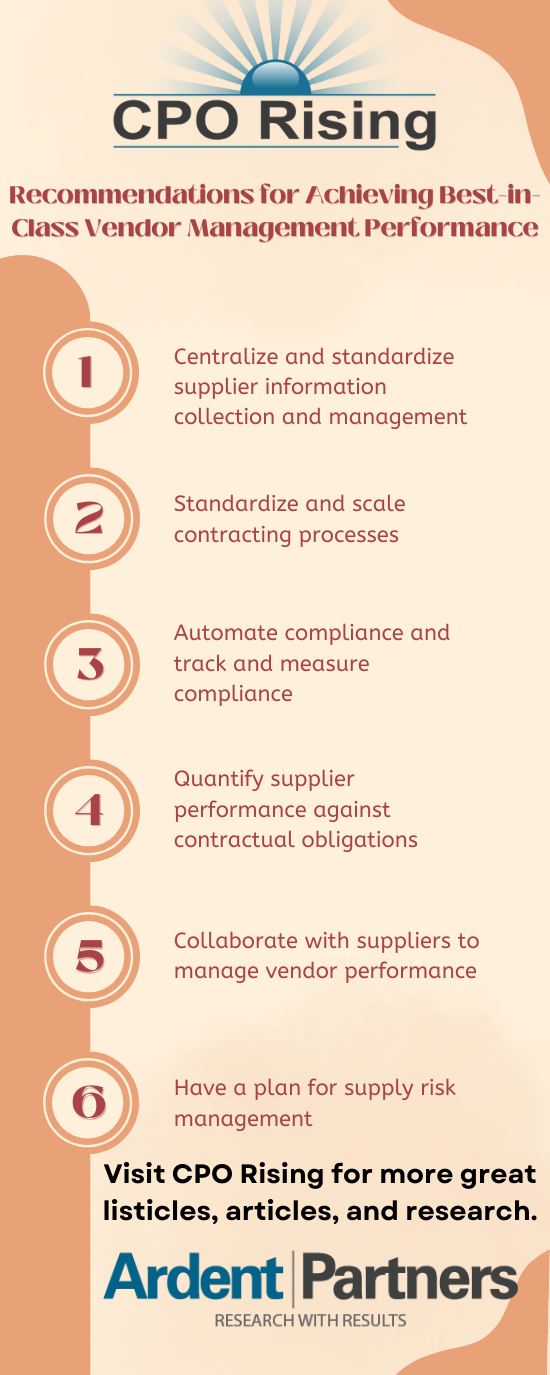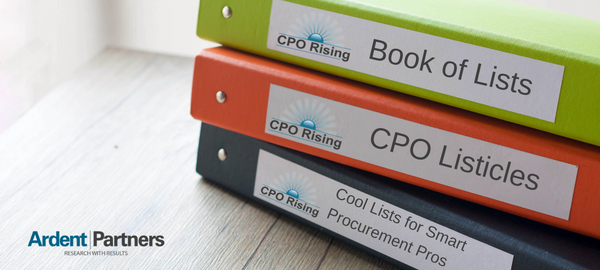Fridays (in 2023) means that it’s time for another CPO Rising Listicle. Each list will include a variety of procurement tips, trends, insights, research, lists, strategies, and/or recommendations designed to help procurement teams improve operations. We’ll also include a summary graphic for you to share with your team.
It appears to be vendor management week on CPO Rising!!
Effective vendor management is critical to controlling spend and maximizing the value obtained from suppliers. Investing in vendor management can help organizations drive value without the significant investment of additional resources. Therefore, it is important to focus on managing supplier relationships and performance to support business operations.
Six Recommendations for Achieving Best-in-Class Vendor Management Performance:
- Centralize and standardize supplier information collection and management: By centralizing and standardizing the collection and management of all key sub-vendor information, organizations can improve communication and initiate collaboration with suppliers. Building out a source-to-pay process that engages and attracts suppliers is also essential.
- Standardize and scale contracting processes: Standardizing and scaling contracting processes has a direct impact on efficiency, budgets, and streamlined procedures. Contract management solutions can also result in efficiency dividends for suppliers.
- Automate compliance and track and measure compliance: Non-compliant spend costs the average enterprise an extra 12 to 18%. Organizations must automate compliance, clearly communicate compliance requirements, and track and measure compliance. Involving finance in the process can help procurement realize more value from contracts and strategic suppliers. Additionally, ESG initiatives are becoming increasingly important, and organizations must ensure their vendors meet these standards.
- Quantify supplier performance against contractual obligations: Traditional vendor performance management utilizes surveys and scorecards to evaluate supplier performance. However, it is essential to conduct a more quantified analysis of how the supplier performs against the details of its contractual obligations.
- Collaborate with suppliers to manage vendor performance: Contracts have become more complex, resulting in conflict between organizations and suppliers. Collaborating with suppliers and going deeper than classic vendor performance management can help manage vendor performance effectively.
- Have a plan for supply risk management: Supply risk management is still a blind spot for many organizations, and it is essential to have a plan for managing supply risk. Contracts can help mitigate risks, and having a supplier risk management component to a larger vendor management program ensures that organizations can respond to risk events quickly.
In conclusion, vendor management is a critical component of procurement, and it is essential to manage supplier relationships and performance effectively to support business operations. By following the above recommendations, organizations can achieve best-in-class performance and drive value from their vendor relationships.

RELATED RESEARCH
Seven Keys to Better Sourcing and Supplier Management, Part One: Know Your Spend
Seven Keys to Better Sourcing and Supplier Management, Part Two: Early Engagement
Seven Keys to Better Sourcing and Supplier Management, Part Three: Tighter Specifications
Seven Keys to Better Sourcing and Supplier Management, Part Four: Clear Communication
Seven Keys to Better Sourcing and Supplier Management, Part Five: Efficient (and Robust) Evaluations
Seven Keys to Better Sourcing and Supplier Management, Part Six: A Warm Welcome

